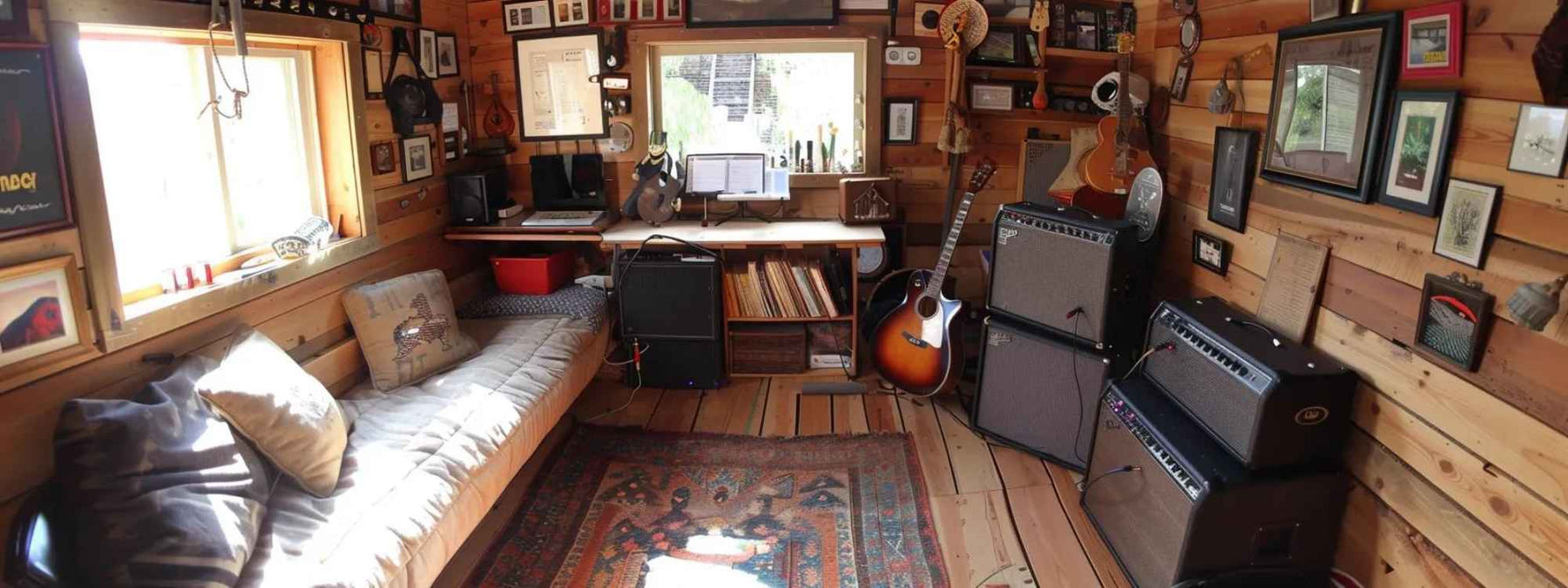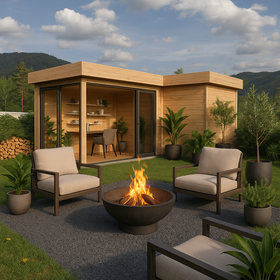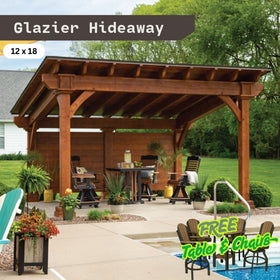512-777-0154

How to Decorate an Outdoor Music Room?
Ever feel like your instruments are crammed into whatever space is left over? Maybe a dusty corner in the garage. Or a makeshift setup in the shed. It works, for now. But it doesn’t exactly inspire your next jam session.
What if you had a dedicated space outside, something intentional, cozy, and designed just for music? Not a stage. Not a studio. Just a place to play, think, or sit back and listen. Bonus if it’s in a tiny house tucked in your backyard.
That’s what we’re talking about here. An outdoor music room that’s not just functional, but enjoyable to be in. Smart design choices that help the space feel creative and relaxed.
We’ll walk through 8 practical ways to decorate your outdoor music room. Simple stuff. Nothing expensive or complicated. Just ideas that help you create a place that fits your style and your sound.
1. Start by deciding the vibe, not just the gear
Before you even think about furniture. synthesizer, or amp, figure out the feel.
Do you want the space to be laid-back and earthy? Or maybe something clean and modern with a few sharp lines? Some people lean into the “retro jam cave” look, vinyl, Crosley Lancaster Entertainment Center - Paprika, wood panels, the works. Others keep it simple with soft lighting and minimal clutter.

Either way, it helps to base your decisions on the kind of music you love. Jazz fans might go for velvet cushions, carpet, and warm bulbs. Rock fans? Maybe darker tones, brushed metal, drum kit, and some classic posters.
If you’re stuck, create a quick mood board. Pinterest works. So does a saved folder on your phone.
Just don’t skip this step. It’s easier and cheaper to build a room around a clear vibe than it is to wrestle with mismatched gear and furniture down the line.
2. Choose weather-smart materials that still look cool
Here’s the thing about outdoor music rooms: they’re still outdoors. So you’re dealing with moisture, wind, dust, and bugs. Even if your setup is inside a tiny dream home, it’s smart to use materials that can take a little wear without falling apart.
Start with the big stuff. Teak benches, composite stools, and powder-coated metal frames are durable and look good. Vinyl rugs are another solid option; they clean easily and won’t soak up moisture.
Inside the GardenHouse24 USA Farum 44 Garden Room, go with washable curtains, soft but durable fabrics, and a few low floor cushions that won’t get ruined if the windows are open during a drizzle.
You can also stretch the life of your outdoor furniture with covers or protectant sprays. Nothing fancy. Just enough to stop mildew or fading from ruining your setup halfway through summer.
3. Think multifunctional: furniture that works as storage and seating
Small houses = tiny footprint. You don’t need less stuff, you just need smarter stuff.
That means furniture that earns its spot. A bench with storage under the seat. Cube ottomans that hide cables, pedals, or extra strings. Even a wall-mounted desk you can fold down when it’s time to work on lyrics or setlists.
Multifunctional pieces keep the place looking clean and make your life easier.

Want to make the most of your walls? Hang a few hooks for guitars or cords. Add shelves for Crosley S100 Bluetooth Enabled Powered Speakers, headphones, or that small plant you keep forgetting to water.
Every square inch matters in micro homes. So choose pieces that help you stay organized without giving up comfort or style.
4. Add sound-softening decor so it doesn’t echo like a cave
Hard surfaces and open air make sound bounce around in weird ways. Not great for music.
To fix that, bring in a few soft materials. Outdoor rugs help ground the space and absorb noise. Floor cushions do the same, plus they double as seats. Hanging fabric panels or canvas prints on the walls can also cut down on reverberation without making the room feel heavy.
You don’t need to turn the place into a recording studio. But even a little sound control goes a long way, especially in Sawmill Structures Multi Cube Versa 100.
There are acoustic panels that don’t look like tech gear. Some are shaped like tiles or art prints. They blend in. They work. And your neighbors will appreciate it too. Especially if you like to turn things up after sunset.
5. Go wireless or at least cable-tidy
Nothing ruins a calm, intentional setup faster than a nest of tangled cords.

Unfortunately, music gear and electronics come with a lot of wires. Power cables. Instrument cables. Charging cables. The whole gang. And if you’re not careful, they’ll take over small homes.
Where you can, go wireless. A Bluetooth speaker. Battery-powered amp. Wireless headphones or mic. It doesn’t have to be high-end.
Still need cords? Fair enough. Just give them somewhere to live. Use cord covers that blend in. Mount cables under shelves with clips or velcro straps. Woven baskets work great for hiding power strips without trapping heat.
The goal here is to keep things out of sight, so your mini house stays calm and focused.
6. Let there be lighting, but keep it soft, not stagey
Harsh lighting kills the mood.
If you’re setting up an outdoor music room with acoustics, think warm and low. String lights add a soft glow without taking over. Solar lanterns are easy to hang and recharge on their own. LED tape under a shelf or bench can light the space without calling attention to itself.
Try dimmable lights if you can. Or smart bulbs you can adjust from your phone. Want a little color? Use it sparingly. No one wants a rave when they’re trying to write lyrics.
Motion sensors can help too, no fumbling for switches if your hands are full.
The lighting doesn’t have to be dramatic. Just enough to set the tone, so your music room feels like a place worth spending time in.
7. Decorate with a few personal touches

You’re not building a music studio showroom. You’re creating a space that feels like you. That doesn’t take much. Just a few things that remind you why you love music in the first place.
Here are some ideas:
- A framed album cover that changed your life
- An old concert poster with a story behind it
- A small vinyl crate like Crosley Record Storage Crate - Natural with your favorite records
- A vintage radio, even if it doesn’t work
- A plant with a little attitude (low-maintenance is best)
You could even hang a chalkboard or whiteboard for lyrics, guest signatures, or random song ideas.
Just don’t clutter the music man cave. Too many personal items can turn it into storage instead of a sanctuary. A handful of the right ones will do more than a dozen random decorations ever could.
8. Make it flexible for solo jams, duets, or just relaxing
Your outdoor music room won’t always be used the same way.
Some days it’s just you and a guitar. Other times, a friend might stop by. Or maybe you just want to sit down with a drink and let Spotify handle the vibe.
So don’t overcommit to one setup.
Keep a few lightweight stools around. Bean bags work too. Use folding stands that can disappear when not in use. A small cart on wheels can carry gear or snacks, whatever the day calls for.
Design the room to shift with you. Need more space to rehearse? Move the seating. Hosting someone? Pull out an extra cushion.

Decorating isn’t just about how it looks. It’s about how it works. A flexible space lets you enjoy music in whatever way makes sense that day. That’s the kind of design that keeps working long after the novelty wears off.
Don’t stress, your tiny music room will evolve
You don’t need to nail it on day one.
Start simple. Add what you need. Rearrange when something feels off. That’s how most great spaces come together by living in them.
Your outdoor music room isn’t a design project. It’s a space you’ll grow into. What feels perfect now might shift after a few jam sessions or quiet afternoons with a playlist in the background.
So don’t overthink every little detail. You’ll tweak the layout. Swap out a chair. Hang something new on the wall.
The real goal? Comfort. A little personality. Flexibility. That’s what makes the space worth coming back to.
If you’re planning to build your own tiny house setup, take a look at our outdoor freedom rooms. They’re a good starting point if you want something that works right out of the box and still feels personal.
Because at the end of the day, it’s not about perfection. It’s about creating a space where the music feels good. And so do you.



